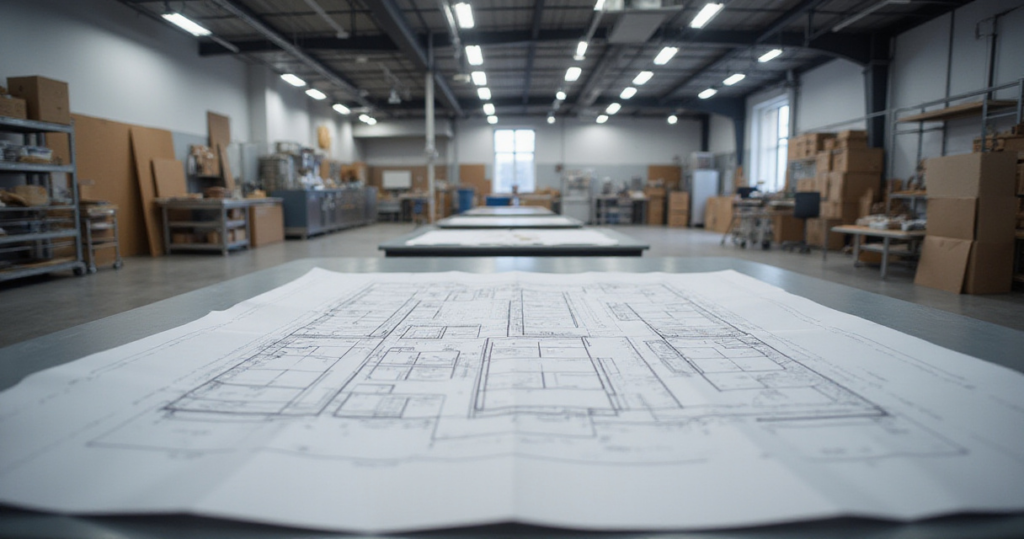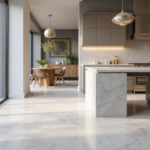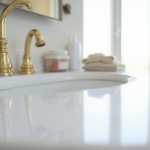Designing an industrial kitchen is far more complex than creating a residential cooking space. It’s about engineering a high-performance environment where every square foot serves a purpose, every workflow is optimized, and every decision impacts your bottom line. Whether you’re planning a bustling restaurant kitchen, a large-scale catering facility, or an institutional dining operation, the stakes are incredibly high.
The difference between a thoughtfully designed industrial kitchen and a poorly planned one can mean the difference between smooth operations and constant bottlenecks, between profitable margins and escalating costs, between happy staff and high turnover. A well-executed industrial kitchen design doesn’t just look professional – it transforms how your entire operation functions, reducing waste, increasing speed, and creating a safer environment for your team.
This comprehensive guide reveals 24 essential strategies that separate exceptional industrial kitchens from mediocre ones. From the critical planning phases through equipment selection, safety considerations, and future-proofing, these insights will help you create a kitchen that performs beautifully today while adapting to tomorrow’s demands.
1. Define Menu and Operational Needs First
Before any equipment is specified or lines are drawn, successful industrial kitchen design begins with a deep analysis of your menu and operational workflow. This foundational step determines everything from equipment selection to staff movement patterns, ensuring every design decision supports your specific production requirements rather than forcing your operation to adapt to a generic layout.
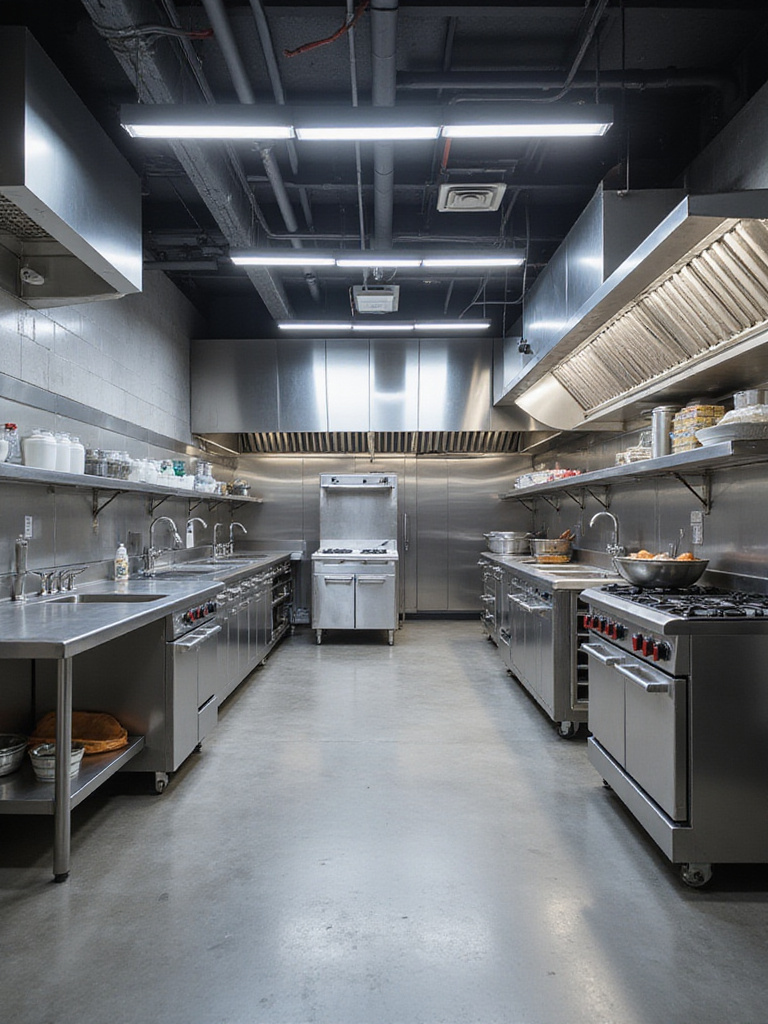
This menu-driven approach delivers immediate financial benefits, typically reducing equipment costs by 10-20% because you’re purchasing only what you need, sized correctly for your projected volume. It also increases staff productivity by 15-25% through optimized workflow paths that eliminate unnecessary movement and bottlenecks. Most importantly, aligning design with your specific menu reduces food waste and improves consistency by creating production zones tailored to your exact requirements.
- Menu Analysis: List every dish, ingredient, and preparation method, categorizing by cooking techniques and complexity levels
- Volume Projections: Calculate daily, weekly, and peak hour production needs for accurate equipment sizing
- Workflow Mapping: Create detailed flow diagrams showing ingredient and staff movement from receiving through service
- Equipment Specifications: Match each piece of equipment to specific menu tasks and volume requirements
Professional kitchen designers emphasize that inefficient layouts can increase labor costs by 15% due to wasted motion and poor workflow. A large-scale central production kitchen for a restaurant chain recently redesigned around their core high-volume items, achieving 20% labor cost savings and consistent quality across all locations through optimized prep and cooking zones.
Once you understand exactly what your kitchen needs to accomplish, the next crucial step involves establishing realistic financial parameters.
2. Determine Your Realistic Budget Parameters
Establishing a comprehensive budget early in the industrial kitchen design process serves as your financial blueprint, guiding every subsequent decision from major equipment selection to construction materials. This critical step prevents costly overruns and ensures your project remains financially viable while achieving operational goals.
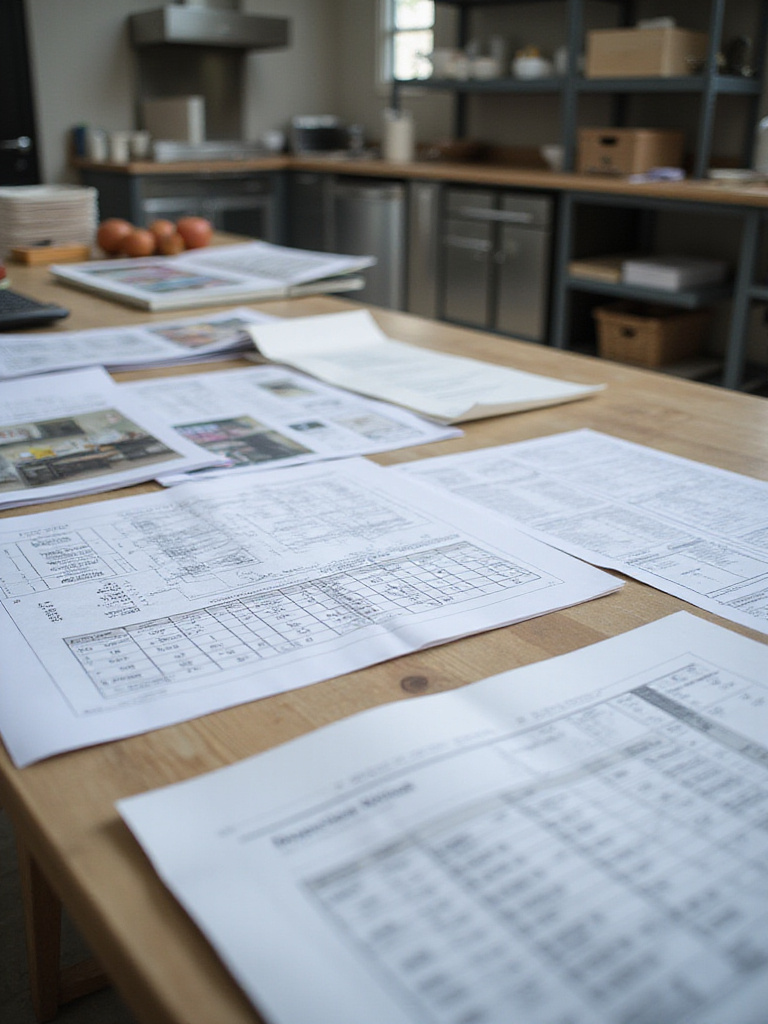
A realistic budget facilitates informed decision-making through value engineering – finding the most cost-effective balance between initial investment and long-term operational savings. Sometimes paying more upfront for energy-efficient equipment delivers significant lifecycle savings. This approach also secures necessary funding and provides benchmarks for tracking expenses throughout the project.
Setting clear financial boundaries requires breaking down costs into major categories: design and consulting fees, permits and inspections, construction and renovation work, MEP (Mechanical, Electrical, Plumbing) systems, major equipment packages, smallwares and tools, installation and commissioning, and initial inventory. Research shows that allocating a 15-25% contingency fund helps cover unforeseen expenses that commonly arise during commercial kitchen projects.
Industry data indicates that industrial kitchen build-out costs range dramatically from $200 to $800+ per square foot, depending on location, size, complexity, and equipment tier. A commissary kitchen project that initially budgeted $1.5 million faced a $300,000 increase when specialized ventilation requirements for high-volume wok stations weren’t adequately researched upfront, highlighting the importance of detailed cost analysis.
With budget parameters established, understanding your physical space constraints becomes the foundation for realistic planning.
3. Assess Available Space and Structural Limitations
Thoroughly evaluating your physical space and existing structural elements prevents costly surprises and ensures your industrial kitchen design maximizes every available square foot. This assessment goes beyond measuring floor space to include ceiling height, load-bearing capacity, utility locations, and architectural constraints that will shape your final design.
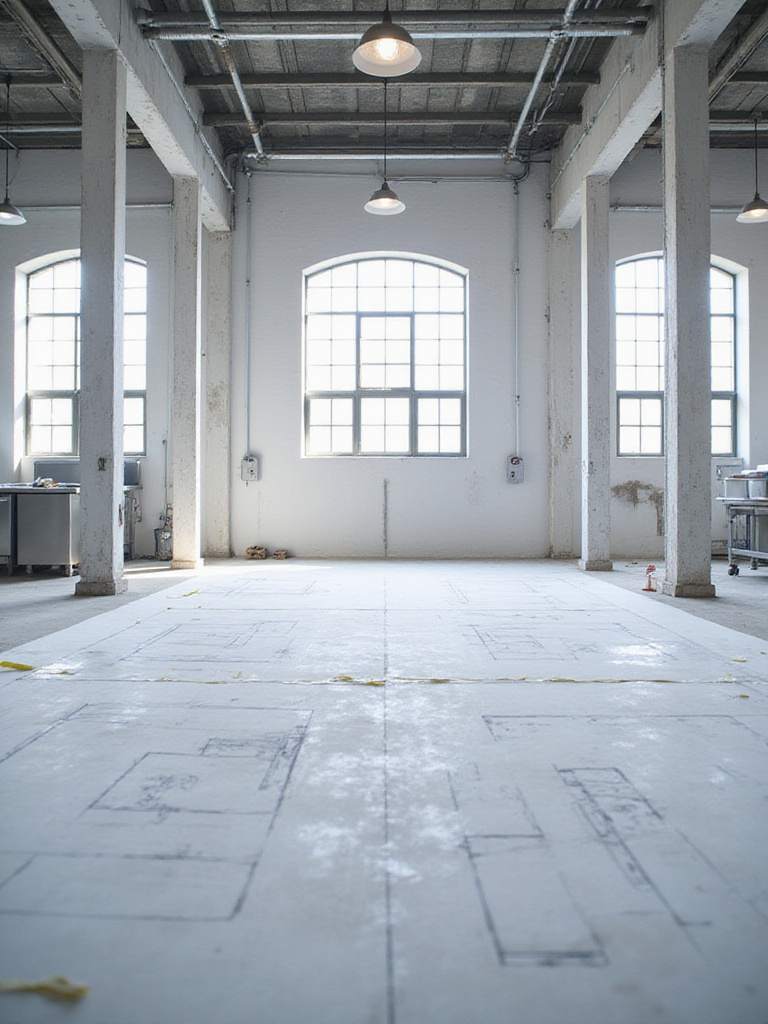
A detailed space assessment can reduce construction cost overruns by 10-20% by identifying structural limitations early in the planning process. It ensures compliance with building codes, fire regulations, and health department requirements by confirming adequate space for equipment clearances, ventilation systems, emergency exits, and accessibility features. Understanding these constraints upfront allows designers to optimize workflow within realistic spatial boundaries, potentially increasing kitchen throughput by 15-25% during peak operations.
Professional site surveys should document exact dimensions, structural elements like columns and load-bearing walls, existing utility connection points, floor drains, windows, and doors. Cross-referencing existing architectural blueprints with current conditions reveals any discrepancies that could impact planning. Consulting with structural and mechanical engineers early helps assess load-bearing capabilities for heavy equipment and ventilation requirements.
- 3D Laser Scanning: Provides highly accurate digital models capturing all dimensions and structural elements
- Load Capacity Analysis: Ensures floors can support walk-in coolers, large ovens, and other heavy equipment
- Utility Assessment: Maps existing electrical, gas, water, and drainage infrastructure
- Code Compliance Review: Verifies space meets all regulatory requirements for commercial food service
A restaurant planning a large combi oven discovered too late that their floor required costly reinforcement and the oven needed partial disassembly to fit through doorways, resulting in 3-week delays and $15,000 in unexpected expenses. Industry reports suggest that change orders due to unforeseen site conditions add 5-15% to total construction costs.
Understanding physical constraints leads directly to ensuring your plans meet all necessary regulations and codes.
4. Consult Design Experts for Code-Compliant Plans
Navigating the complex web of health, safety, building, and fire codes requires specialized expertise that only experienced industrial kitchen design professionals possess. These experts understand how to interpret and apply regulations specific to commercial food service environments, preventing costly violations and ensuring smooth approval processes.
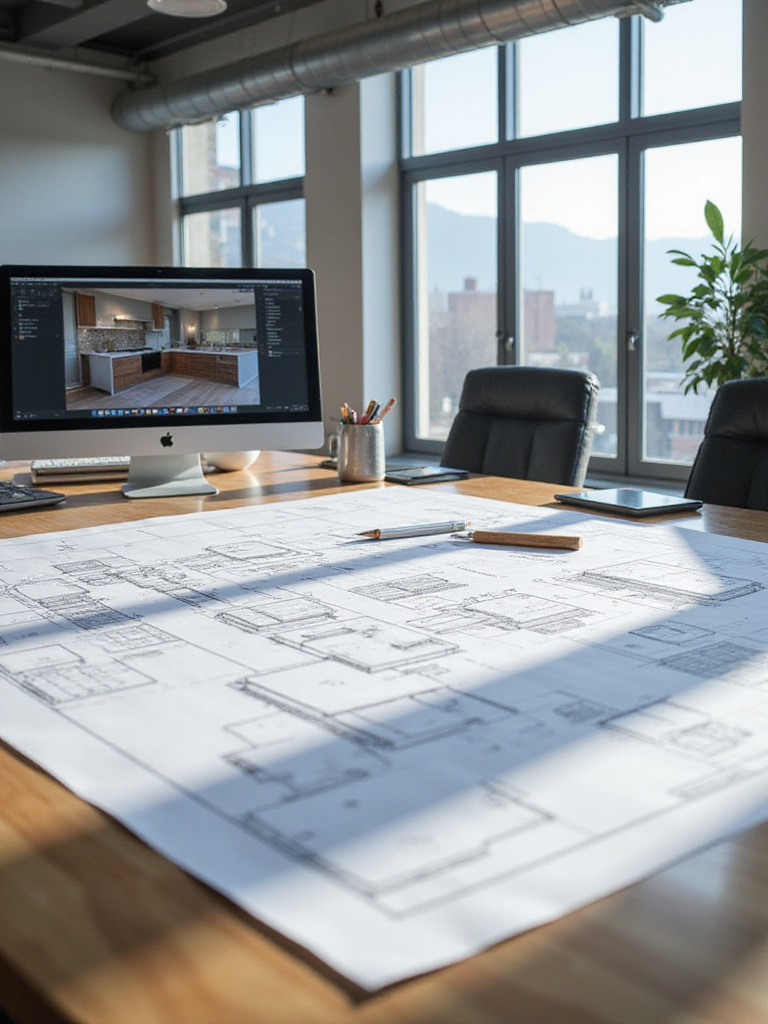
Engaging qualified design experts significantly reduces the risk of code violations and associated fines while expediting plan review and approval with local authorities. This can cut weeks or months off project timelines and minimize expensive rework during or after construction. Code compliance forms the foundation for safe, sanitary, and legally operating kitchens – it’s not just bureaucratic paperwork but essential protection for your investment and reputation.
Expert guidance typically saves 2-10% of total project costs by identifying and resolving code conflicts during the design phase rather than during construction. These professionals maintain relationships with local health departments, building officials, and fire marshals, understanding specific interpretation nuances that can make or break approval processes.
When selecting design experts, research firms with proven experience in commercial kitchen projects and strong familiarity with local regulatory requirements. Request examples of plan sets they’ve successfully submitted to your specific local authorities to gauge their expertise and relationships with approval departments. Engage them early in the planning phase, before finalizing layout concepts or selecting major equipment.
A national restaurant chain hired a specialized architectural firm with extensive food processing facility experience for their commissary kitchen project. The firm’s detailed code review resulted in first-submission approval from local authorities, avoiding typical 6-8-week resubmission delays and keeping the project on schedule.
With compliance addressed, the focus shifts to optimizing the core function of any kitchen – workflow efficiency.
5. Design a Workflow Layout for Maximum Efficiency
Creating an optimal workflow layout involves strategically arranging equipment, workstations, and storage areas to facilitate smooth, logical movement of ingredients, staff, and finished products. Effective industrial kitchen design minimizes wasted time and motion while maximizing throughput in high-volume environments, forming the backbone of productive operations.
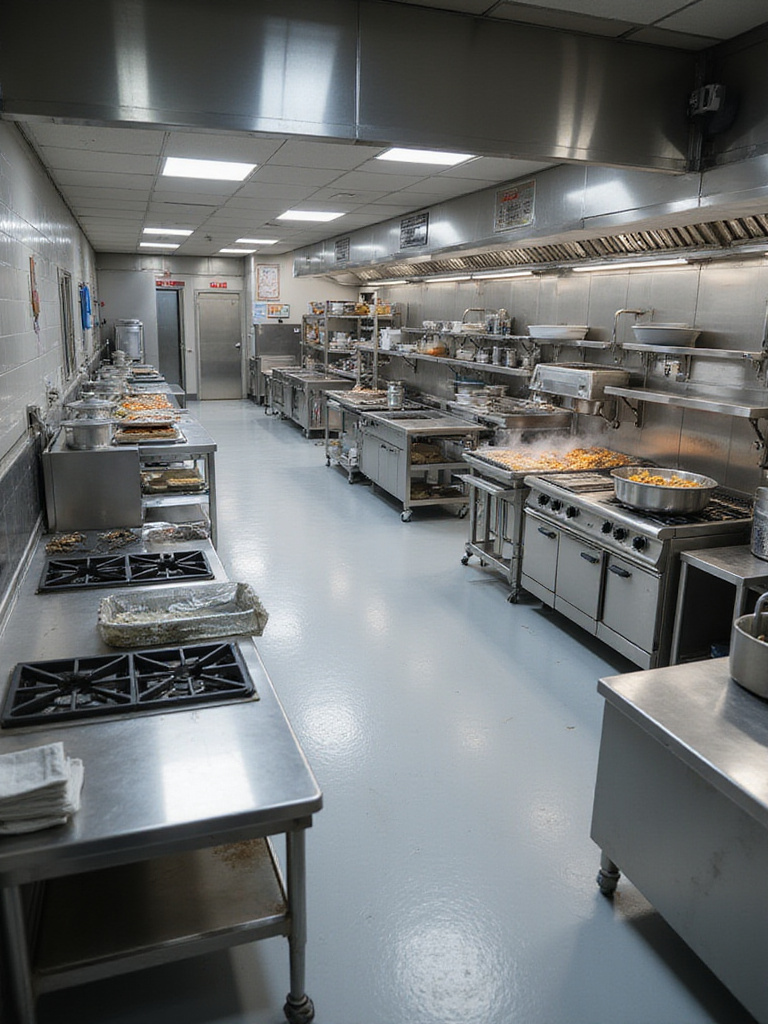
Well-designed workflow layouts reduce staff travel time and associated labor costs by 20-30% through minimized unnecessary steps. They increase food preparation speed and service throughput by eliminating bottlenecks and improving flow patterns. The golden rule of kitchen design focuses on minimizing steps – every step saved translates to time saved, labor costs reduced, and decreased potential for errors or accidents.
Logical layouts also minimize cross-contamination risks and workplace accidents by separating clean and dirty zones while reducing traffic congestion. Workplace safety studies suggest that proper zoning and workflow design can reduce kitchen accidents by up to 25% through improved organization and clearer traffic patterns.
- Zone Definition: Establish distinct areas for receiving, storage, prep, cooking, service, dishwashing, and waste disposal
- Work Triangle Concept: Optimize relationships between storage, prep, and cooking areas to minimize steps
- Traffic Flow Analysis: Ensure adequate aisle width and strategic placement of pass-throughs
- Staff Communication: Design sight lines and communication points for efficient coordination
A high-volume commissary kitchen implemented a straight-line workflow from receiving through distinct prep, cooking, and packaging zones, achieving a 25% increase in daily production capacity without additional staff. This significantly lowered labor cost per unit produced while improving consistency and quality control.
The foundation of efficient workflow begins with clearly defining the purpose and organization of different kitchen areas.
6. Create Distinct Zones for Prep, Cook, Service
Establishing clearly defined areas for food preparation, cooking, and service within your industrial kitchen design optimizes workflow, enhances safety, and maximizes efficiency. This zoning approach prevents cross-contamination, reduces unnecessary staff movement, and creates logical progression from raw ingredients to finished plates.
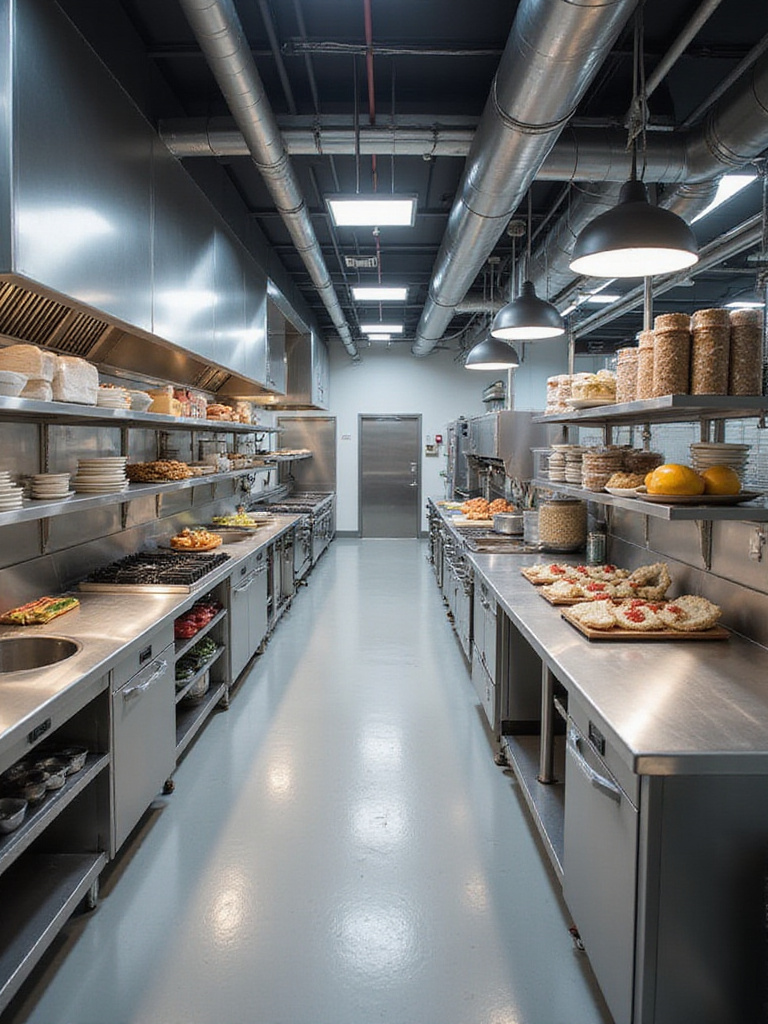
Proper zoning increases operational efficiency by reducing staff travel time, potentially cutting labor costs by 15-20% in well-organized kitchens. It critically enhances food safety by minimizing cross-contamination risks between raw ingredients in prep zones and ready-to-eat items in service areas. According to food safety experts, separating raw prep areas from ready-to-eat plating areas represents a critical control point for preventing foodborne illness outbreaks.
Effective zoning also improves order accuracy and service speed by creating unimpeded flow from cooking lines to plating areas, while reducing workplace accidents through decreased traffic congestion. Studies indicate that optimizing kitchen layout through strategic zoning can reduce total staff steps during shifts by 30-40%, directly impacting productivity and fatigue levels.
Implementation requires analyzing your menu and workflow to map typical ingredient journeys, then allocating distinct physical spaces for each operational phase. Position necessary equipment within respective zones – sinks and cutting boards in prep areas, ranges and ovens in cooking zones, heat lamps and plating surfaces in service areas. Install physical or visual separators to clearly delineate zones while ensuring adequate space for tasks and staff movement.
A large university cafeteria renovated their kitchen with distinct zones for salad prep, hot food cooking, and dedicated plating areas, reporting a 25% reduction in average meal service time during peak hours and decreased staff complaints about congestion.
Following the logical flow from prep through cooking to service, optimizing storage becomes the next critical element.
7. Optimize Storage Zones for Easy Access & Inventory
Effective storage optimization in industrial kitchen design ensures ingredients, equipment, and supplies remain easily accessible while maintaining accurate inventory control. This crucial element minimizes time wasted searching for items, reduces food spoilage, and streamlines workflow from receiving through prep and service operations.
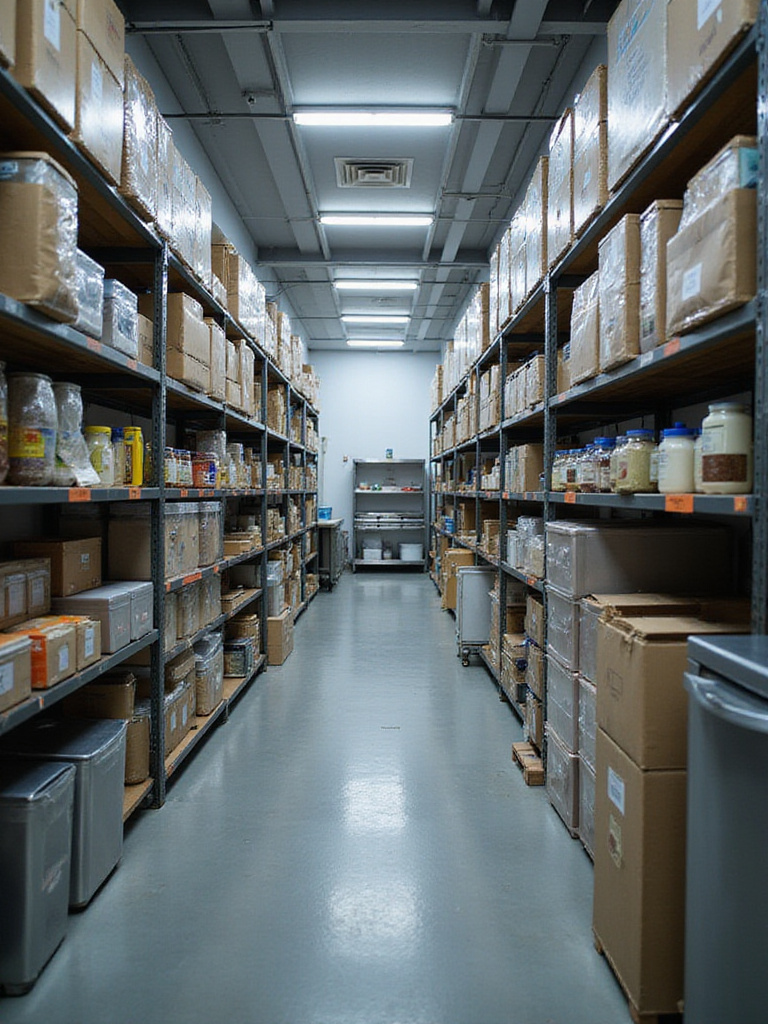
Optimized storage zones reduce food waste by 10-15% annually through improved FIFO (First-In, First-Out) implementation and enhanced visibility of inventory. They decrease labor costs by 5-10% by reducing search time and improving inventory management efficiency, while increasing inventory accuracy to 95%+ levels for better purchasing decisions and reduced stockouts.
Intelligent space utilization goes beyond having adequate storage – it requires strategic placement of frequently accessed items closest to their point of use, vertical space maximization, and mobile shelving systems that drastically reduce staff steps and search time during peak operations. Poor inventory management linked to disorganized storage contributes to 4-10% of food costs being lost to waste and spoilage.
- Usage Analysis: Conduct detailed inventory audits to understand storage needs, quantities, and access frequency
- Zone Designation: Create dedicated areas for dry goods, refrigerated items, frozen products, chemicals, and smallwares
- Mobile Shelving: Utilize track-based or wheeled units to maximize cubic footage without sacrificing accessibility
- Labeling Systems: Implement consistent, clear identification and FIFO rotation procedures
A high-volume restaurant installed mobile shelving units in their walk-in cooler with digital inventory tracking, increasing storage capacity by 20% in the same footprint while reducing item location time by 15 minutes per shift. This improvement led to faster service and reduced frustration for kitchen staff.
Moving from ingredient storage optimization, the next vital function involves efficiently cleaning and returning items to service.
8. Lay Out a Dishwashing Zone for Fast Turnover
An efficiently designed dishwashing zone maintains smooth flow of clean dishes, glassware, and utensils back into service, directly impacting your kitchen’s ability to handle peak demand and achieve rapid table turnover. Strategic industrial kitchen design in this area minimizes bottlenecks, reduces labor time, and ensures consistent hygiene standards.
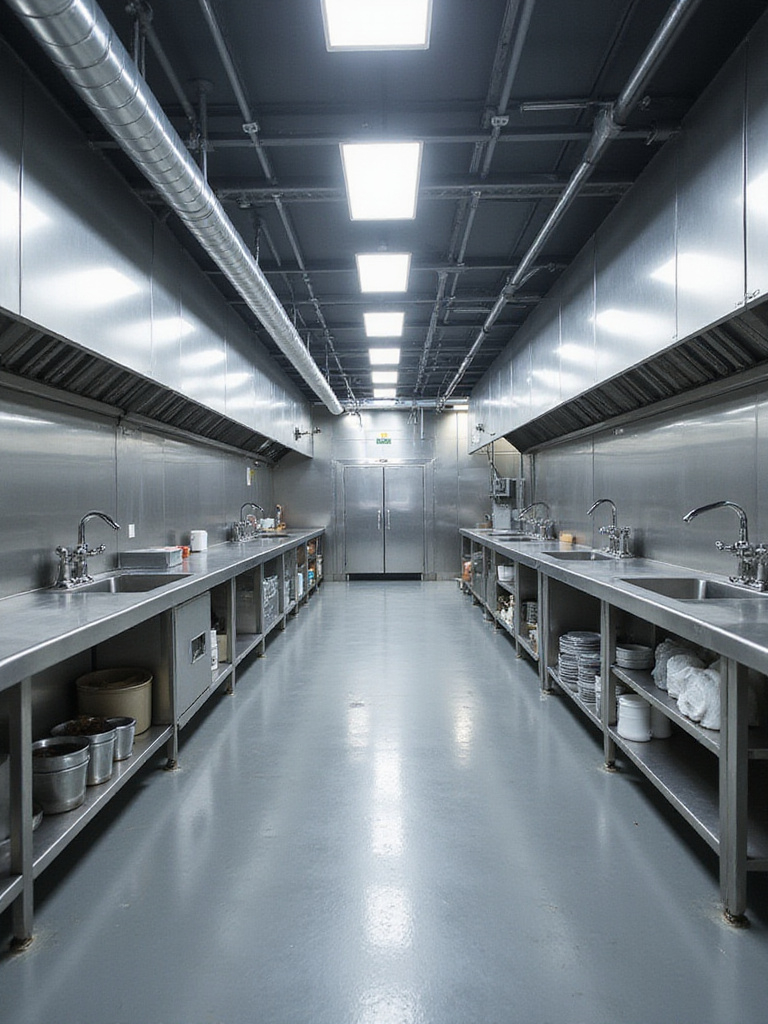
Well-planned dishwashing zones reduce labor costs by 15-20% through optimized workflow and reduced handling time, while significantly increasing dining area table turnover speed by ensuring constant supply of clean tableware. This can potentially add 1-2 turns during peak hours, directly impacting revenue. The dishroom functions as the engine room for front-of-house operations – bottlenecks here slow the entire operation regardless of kitchen speed.
Efficient zones also minimize dish breakage by up to 50% through designated handling areas and reduced clutter, while improving hygiene scores by facilitating proper scraping, washing, and sanitizing procedures. Since labor typically accounts for 25-35% of restaurant operating costs, efficiency improvements in high-labor areas like dishwashing create particularly significant impact.
Design requires mapping the complete path of soiled items from drop-off through scraping, racking, washing, rinsing, sanitizing, drying, and storage. Create a linear, one-way flow that strictly avoids cross-traffic between soiled and clean items, while allocating sufficient counter space for each operational phase. Select equipment sized for peak volume and integrate waste management at strategic points.
A large university cafeteria redesigned their dishwashing zone from chaotic setup to single, linear flow with integrated pulpers and conveyor systems, reducing required staff by 3 FTEs during peak hours and decreasing average dish processing time by 40%.
Beyond layout optimization, the longevity and performance of your kitchen depends heavily on equipment quality and selection.
9. Select Durable Equipment to Reduce Long-Term Costs
Investing in high-quality, durable equipment represents a critical strategy for minimizing operational expenses throughout your industrial kitchen design lifecycle. While initial costs may be higher, long-term savings from reduced repairs, decreased downtime, and extended replacement cycles significantly outweigh upfront investments.
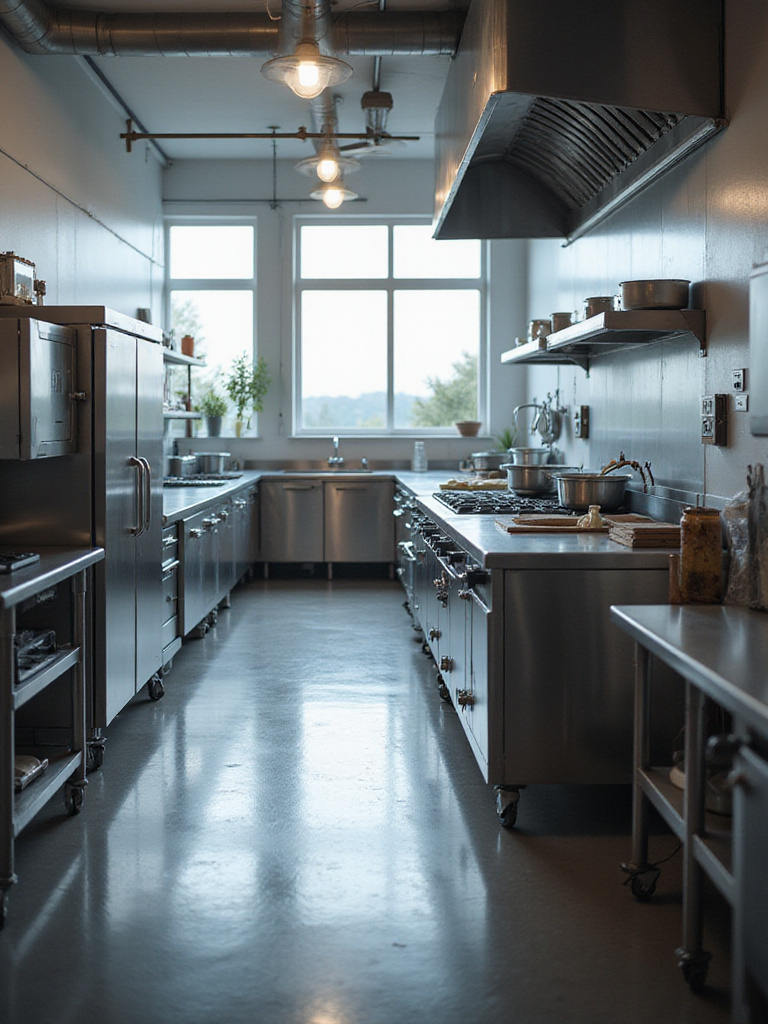
Durable equipment achieves 15-25% reduction in annual maintenance and repair costs by minimizing breakdowns associated with cheaper materials and construction. It extends equipment lifespan by 5-10+ years compared to lower-quality alternatives, delaying significant capital expenditures on replacements while reducing operational downtime by 5-10% annually through fewer failures during peak service.
The biggest mistake operators make involves focusing solely on purchase price rather than Total Cost of Ownership (TCO). Equipment that costs slightly more upfront but lasts twice as long with half the breakdowns represents far better long-term investment. Commercial kitchen equipment repairs range from $100 to over $1,000 per incident, highlighting potential savings from reduced breakdown frequency.
- Material Quality: Prioritize heavy-gauge stainless steel (14-16 gauge) and commercial-grade components designed for continuous use
- Manufacturer Reputation: Research reliability records, warranty periods, and industry certifications like NSF or UL
- TCO Analysis: Factor initial price, energy consumption, maintenance costs, expected lifespan, and repair expenses
- Professional Consultation: Engage experienced kitchen designers familiar with equipment demands in specific environments
A large university cafeteria replaced mid-range combi ovens with premium heavy-duty models, reporting 40% reduction in emergency repairs over five years and extending projected replacement cycles by 7 additional years, resulting in significant cumulative savings.
While durability addresses repair and replacement costs, energy efficiency tackles another major long-term expense.
10. Choose Energy-Efficient Appliances to Lower Utility Bills
Selecting energy-efficient appliances for your industrial kitchen design creates a direct path to increased profitability through substantially lower utility bills while minimizing environmental impact. These appliances utilize advanced technologies to perform tasks using significantly less energy and water compared to standard models, contributing to more sustainable and profitable operations.
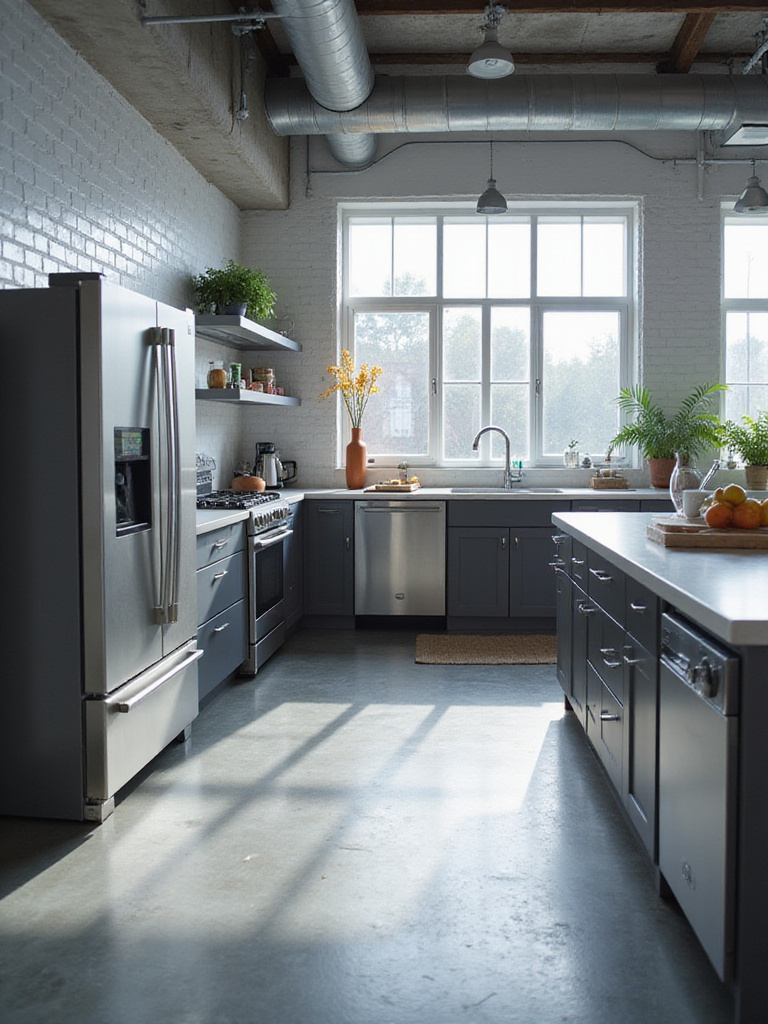
Energy-efficient appliances reduce energy consumption by 10-60% depending on appliance type and usage patterns, leading to substantial savings on electricity and gas bills. They also lower operational costs through reduced peak demand charges and potential water/sewer bill savings for efficient water-using equipment. Commercial kitchens use up to 5 times more energy per square foot than other commercial spaces, with cooking and refrigeration being the largest consumers.
Energy efficiency has evolved from a “nice-to-have” feature to an operational imperative in commercial kitchens. Investing in certified energy-efficient equipment pays dividends quickly through reduced utility costs and improved performance, while potentially extending appliance lifespan through optimized design and reduced component strain.
Implementation involves identifying the most energy-intensive items in your design – fryers, ovens, refrigerators, and dishwashers – then researching appliances with recognized certifications like ENERGY STAR. Calculate total cost of ownership factoring purchase price, estimated energy and water costs, and maintenance expenses over expected lifespan. Check for local utility rebates, tax incentives, or grant programs that can significantly offset initial investment costs.
A large university dining hall replaced older equipment with ENERGY STAR certified models, achieving 15% reduction in overall kitchen energy consumption and qualifying for significant utility rebates, leading to projected payback period under three years.
Equipment performance relies heavily on building infrastructure, making utility planning absolutely critical.
11. Plan Utility Connections (Gas, Electric, Plumbing)
Precise planning of gas, electrical, and plumbing connections forms the foundation of efficient industrial kitchen design, dictating equipment placement, operational flow, safety compliance, and long-term costs. This detailed coordination based on specific equipment needs and local codes ensures reliable service while preventing expensive rework during construction.
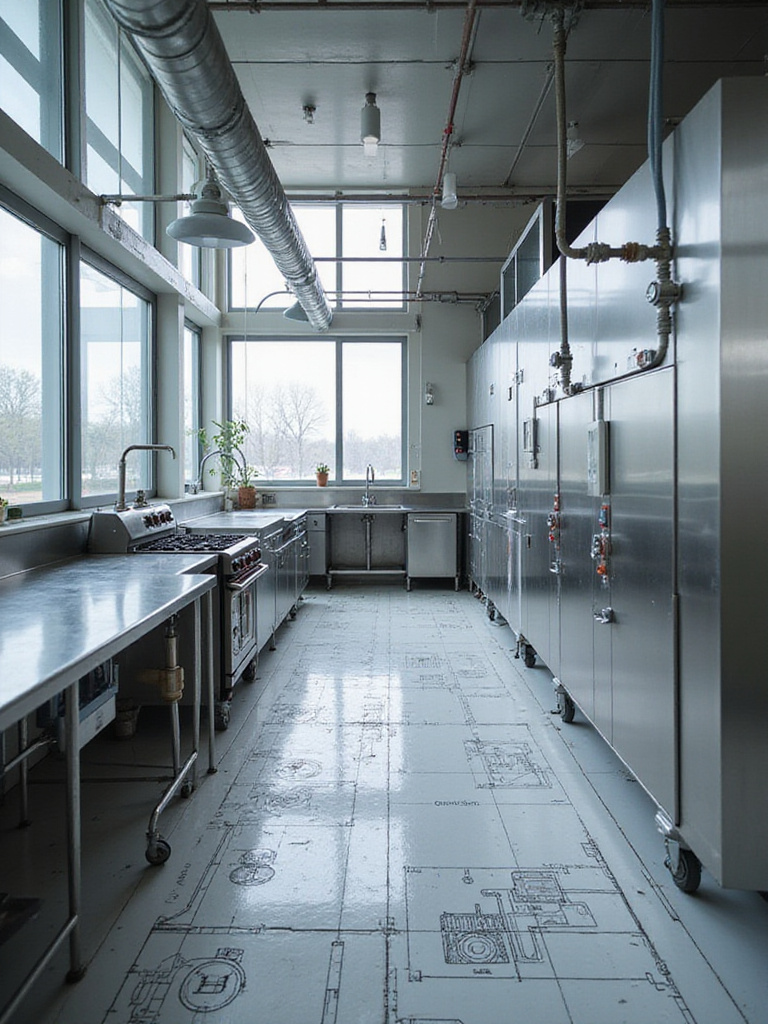
Thorough utility planning reduces construction delays by up to 30% through proactive coordination with contractors and inspectors, while significantly lowering potential for code violations and associated fines. It minimizes equipment downtime and service calls caused by inadequate or incorrectly specified utility supplies, while optimizing operational efficiency through logical equipment placement based on accessible, appropriately sized utility points.
The single biggest cause of delays and budget overruns in kitchen construction stems from inadequate utility planning. Getting equipment specifications locked down early and coordinating religiously with all trades prevents costly surprises. Industry surveys indicate that rework due to unforeseen conditions or design errors accounts for 5-10% of construction costs, with utility conflicts being frequent contributors.
- Equipment Inventory: Document specific utility requirements including BTU for gas, voltage/amperage for electric, GPM/PSI/drainage for plumbing
- Code Review: Research relevant local building, electrical, plumbing, and fire codes thoroughly
- Detailed Drawings: Develop precise utility rough-in drawings showing exact locations, sizes, and connection types
- BIM Integration: Utilize 3D modeling to identify potential utility conflicts before construction begins
A new restaurant discovered their available gas pressure didn’t match high-BTU requirements for planned wok stations and ovens, requiring expensive infrastructure upgrades and causing two-month opening delays. This highlights the critical importance of verifying utility capacity early in planning.
Closely connected to utility planning, especially for cooking equipment, is the absolutely critical need for proper ventilation.
12. Ensure Adequate Ventilation to Meet Health Codes
Proper ventilation in industrial kitchen design serves as the primary system for removing smoke, grease-laden vapors, heat, carbon monoxide, and odors generated by cooking equipment. Adhering to stringent codes like NFPA 96 and local regulations ensures legal compliance while creating safe, comfortable, and hygienic working environments.
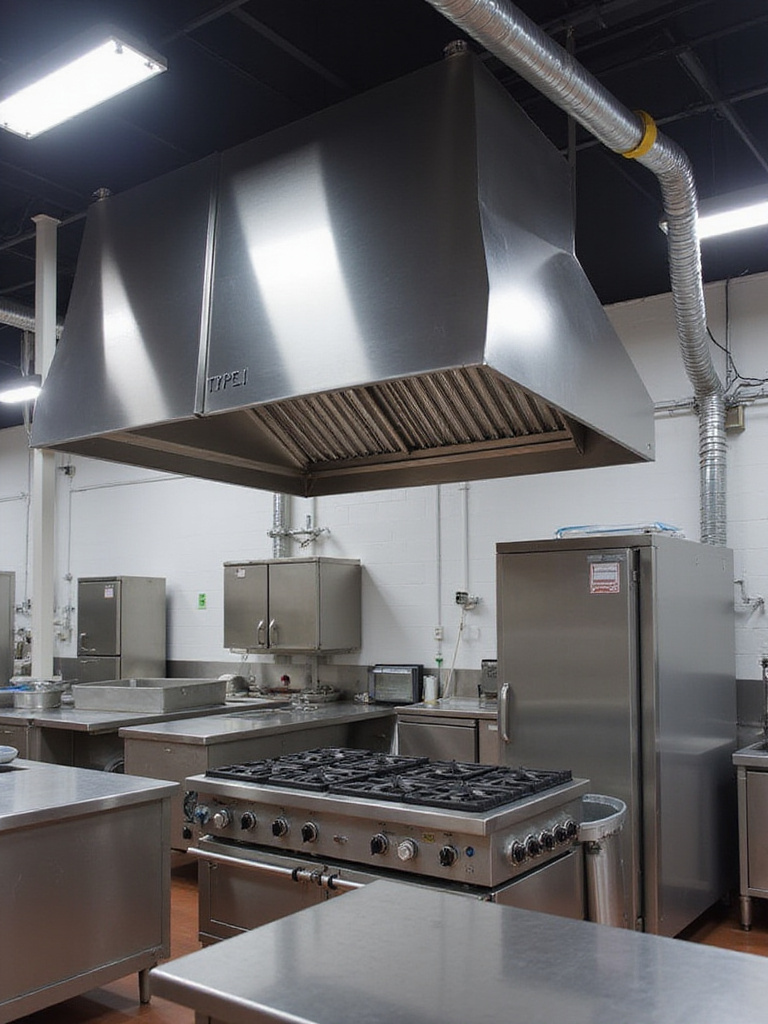
Adequate ventilation ensures documented compliance with NFPA 96 and local codes, avoiding potential fines or operational shutdowns while significantly reducing grease fire risks through effective vapor capture and removal. It improves indoor air quality, leading to fewer staff respiratory issues and more comfortable working temperatures, potentially reducing employee sick days and turnover.
Ventilation represents the lungs of the kitchen – inadequate systems compromise safety, comfort, and compliance. Many operators underestimate the importance of makeup air systems; without proper balance, exhaust systems struggle, creating negative pressure that can pull contaminated air from drains or restrooms. According to NFPA data, cooking equipment represents the leading cause of restaurant fires, often originating from grease buildup in ventilation systems.
Implementation requires conducting thorough heat and grease load calculations based on specific cooking equipment to determine required exhaust airflow (CFM). Select appropriate hood types – Type I for grease/smoke, Type II for heat/moisture – ensuring full coverage of cooking surfaces. Design balanced makeup air systems introducing conditioned fresh air to replace exhausted air, preventing negative pressure issues.
A large hotel kitchen failed health inspection due to insufficient ventilation over a new charbroiler, leading to costly upgrades and operational restrictions during remediation, demonstrating the critical importance of proper system sizing.
Moving from the air above to the surface below, flooring selection proves equally critical for safety.
13. Choose Slip-Resistant Flooring for Enhanced Staff Safety
Implementing slip-resistant flooring represents a fundamental safety measure in industrial kitchen design, significantly reducing slip, trip, and fall incidents – the leading causes of workplace injuries in food service environments. This specialized flooring provides superior traction in wet or greasy conditions common in busy kitchens, directly protecting staff while minimizing operational disruptions.
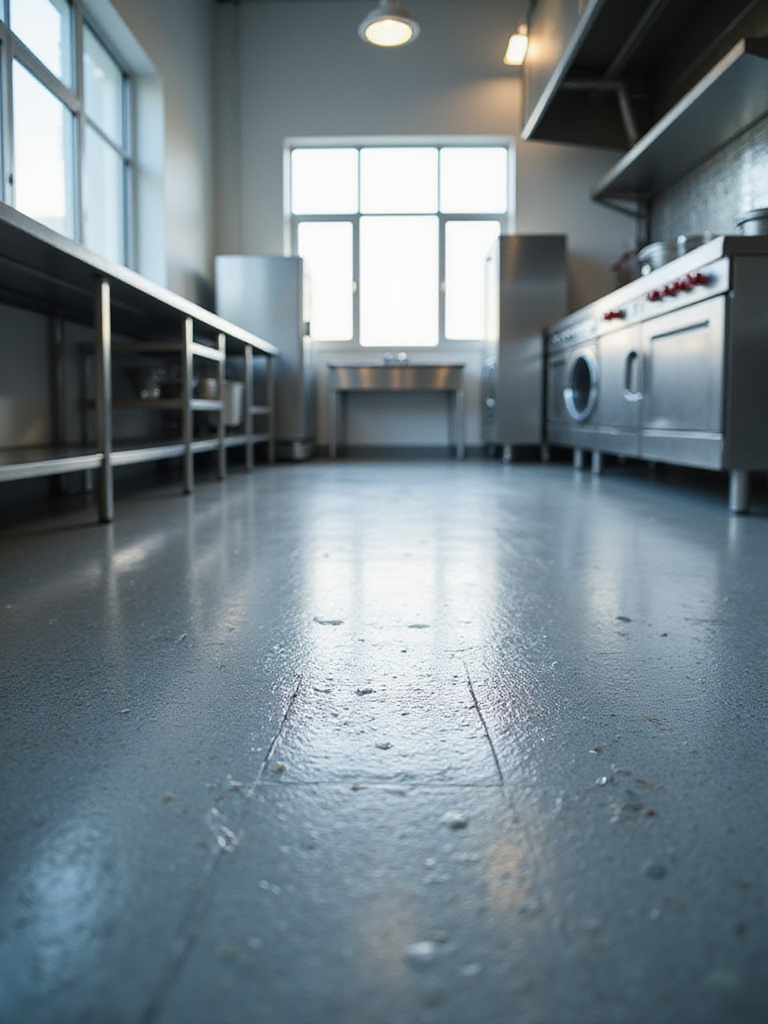
Slip-resistant flooring reduces slip/fall incidents by up to 70% compared to standard flooring in high-risk zones, while decreasing workers’ compensation claims and associated costs that can reach tens of thousands annually. It improves staff morale and confidence by creating demonstrably safer working environments, while helping ensure compliance with OSHA occupational safety regulations.
While initial costs might seem higher, investing in quality slip-resistant flooring costs significantly less than dealing with direct and indirect costs of serious slip-and-fall injuries. Slips, trips, and falls account for 27% of all nonfatal workplace injuries requiring days away from work, with kitchens being particularly high-risk environments due to wet, greasy surfaces.
- Zone Assessment: Identify areas with high moisture, grease, or temperature fluctuations requiring specialized flooring
- COF Ratings: Select materials with appropriate Coefficient of Friction ratings for each specific zone
- Drainage Integration: Coordinate slip-resistant flooring with strategic drainage solutions like trench drains
- Professional Installation: Ensure experienced contractors handle installation with proper subfloor preparation
A national restaurant chain implemented textured epoxy coating in kitchen prep and dishwashing areas, reporting 60% reduction in slip-and-fall incidents within the first year, leading to projected 20% decrease in workers’ compensation claims. Average slip-and-fall accident costs range from $20,000 to $50,000, emphasizing significant financial benefits of prevention.
Complementing safe flooring, wall material selection proves equally important for maintaining hygienic environments.
14. Specify Wall Materials That Simplify Daily Cleaning
Selecting non-porous, durable wall materials resistant to grease, moisture, and chemicals forms a crucial component of efficient industrial kitchen design. This choice directly impacts cleaning speed and effectiveness, ensuring health code compliance while maintaining hygienic environments that protect both staff and customers.
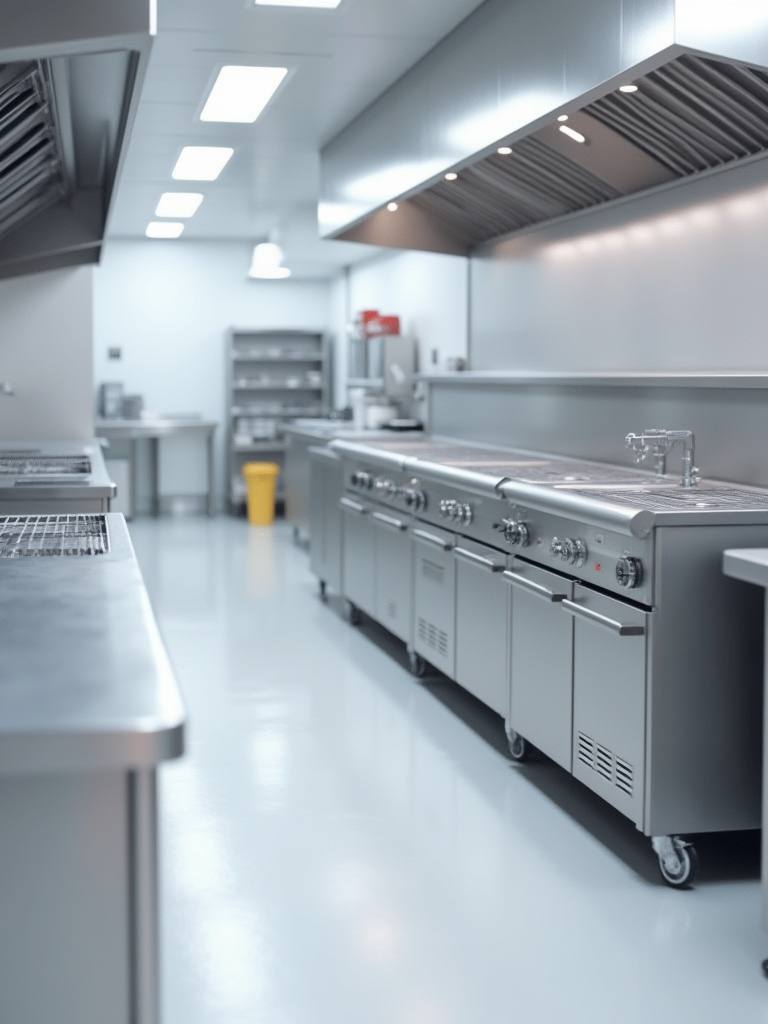
Appropriate wall materials reduce daily cleaning time by 20-30% compared to porous or textured surfaces, directly lowering labor costs while significantly decreasing bacterial growth and cross-contamination risks. They eliminate hidden crevices where pathogens can harbor, extending surface lifespan by resisting damage from frequent washing and chemical exposure, which defers replacement costs and improves health inspection scores.
The biggest time sink in kitchen cleaning often involves walls, especially in high-grease areas. Specifying smooth, non-absorbent materials like FRP (Fiber Reinforced Polymer) or stainless steel upfront represents direct investment in operational efficiency and labor cost reduction over the kitchen’s lifetime. Since labor costs typically represent 30-40% of restaurant operating expenses, any cleaning time reduction creates significant impact.
Implementation requires researching materials compliant with local health codes and NSF/ANSI standards for food zones, evaluating options based on non-porosity, smoothness, durability, and chemical resistance. Specify different materials for various kitchen zones, prioritizing non-porous surfaces in cooking, prep, and dishwashing areas while ensuring seamless installation with proper joint sealing.
A large catering facility switched from painted drywall to FRP paneling in their main production kitchen, reporting 25% reduction in nightly wall cleaning time and measurable improvement in health inspection scores within six months.
Just like walls, food preparation surfaces require equally careful consideration for sanitation and durability.
15. Select Countertop Surfaces for Sanitation & Durability
Choosing appropriate countertop materials proves fundamental in industrial kitchen design, directly impacting hygiene standards and operational longevity. These primary food contact surfaces must withstand heavy use, resist bacterial growth, and facilitate thorough cleaning to ensure food safety while minimizing maintenance costs over time.
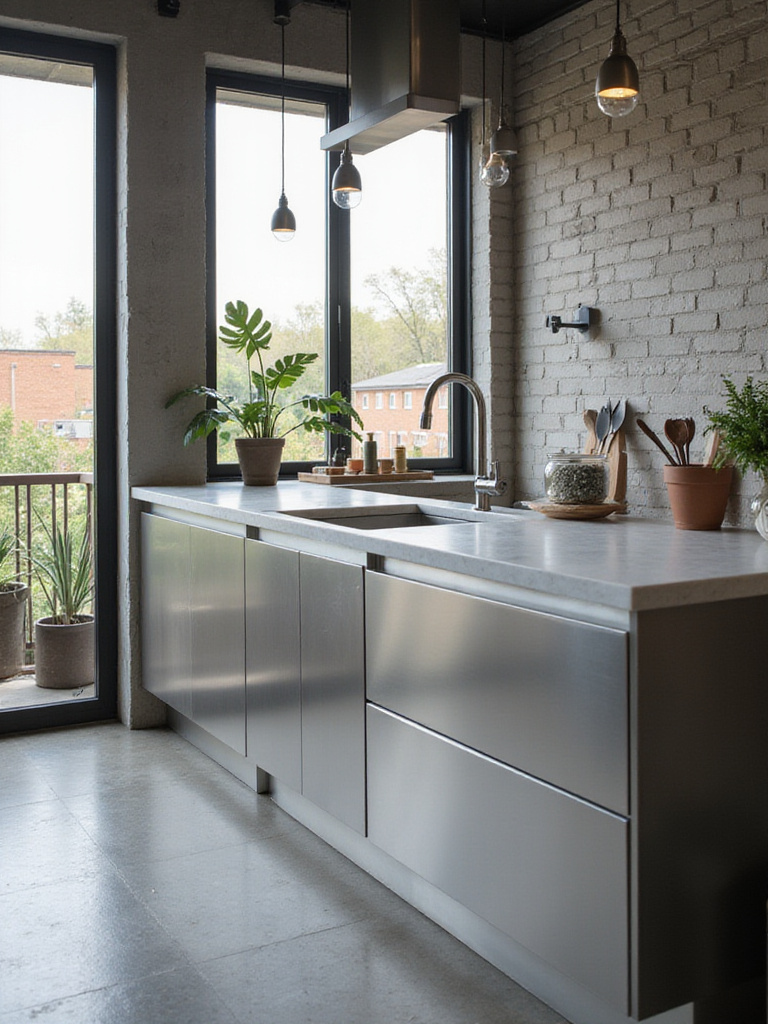
Appropriate countertop surfaces significantly reduce foodborne illness outbreak risks by preventing bacterial harborage and facilitating thorough cleaning, while lowering long-term operational costs through reduced repair and replacement needs. NSF International certification represents the gold standard for food-contact surfaces, ensuring materials remain non-porous, easy to clean, and resistant to food soil buildup – making NSF-listed materials non-negotiable for health and safety compliance.
Quality surfaces also enhance workflow efficiency by providing reliable, stable platforms appropriate for specific tasks like hot prep, cold prep, and plating. Non-porous surfaces meeting NSF/ANSI Standard 51 requirements can be cleaned to bacterial reduction levels significantly higher than porous or damaged alternatives, directly impacting food safety outcomes.
- Zone Assessment: Evaluate specific kitchen areas to determine required resistance properties for heat, moisture, chemicals, and impact
- Material Comparison: Research stainless steel (16-gauge for heavy-duty), quartz, solid surface, and epoxy options
- NSF Certification: Prioritize materials meeting NSF standards for food contact surfaces
- Seamless Installation: Specify integral coved backsplashes and seamless sink installations to eliminate bacterial harborage points
A large university commissary replaced laminate countertops with 16-gauge stainless steel featuring integral coved backsplashes, reporting 15% reduction in cleaning time per shift and consistently higher health inspection scores due to seamless, easily sanitized surfaces.
Moving from work surfaces to illumination, proper lighting significantly impacts work precision and safety.
16. Install Task Lighting for Improved Food Prep Accuracy
Task lighting involves installing focused illumination directly over specific work areas like prep counters, ranges, and cutting stations. This targeted approach proves crucial in industrial kitchen design for reducing shadows, improving visibility, and enabling staff to perform detailed tasks with greater precision and safety.
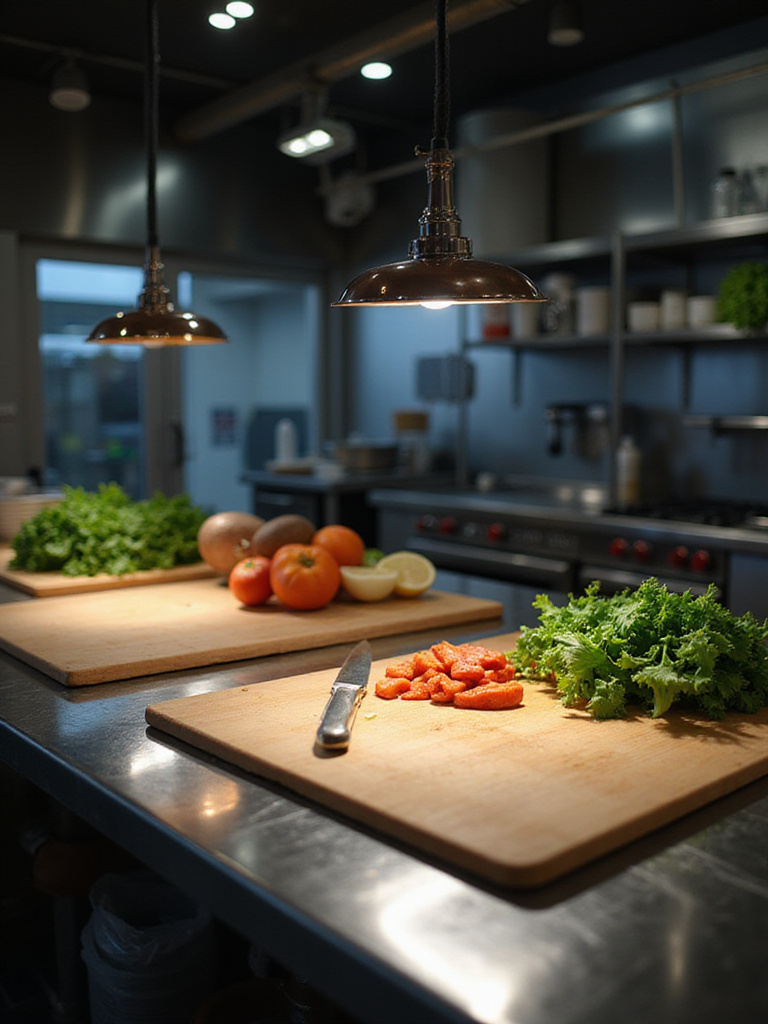
Task lighting reduces visual errors in cutting, measuring, and portioning while increasing speed and efficiency during intricate prep tasks by minimizing eye strain and improving focus. Good task lighting enables accurate assessment of food doneness, color changes in sauces, and precise cuts for garnishes – general ambient lighting simply cannot provide this level of detail for professional cooking requirements.
Quality lighting also enhances food safety by making it easier to spot foreign objects, assess ingredient freshness, and ensure proper cooking temperatures based on visual cues, while minimizing risk of cuts and minor injuries. Studies on workplace lighting suggest that improving illumination leads to 10-15% reduction in errors for visually demanding tasks.
Implementation requires detailed assessment of all workstations where precise visual tasks occur, then selecting appropriate fixtures based on specific tasks and environmental conditions. Determine required light intensity (500-1000 lux for detailed tasks) while ensuring fixtures minimize glare and eliminate shadows. Prioritize lighting with high Color Rendering Index (CRI) – ideally 90+ – to accurately represent food colors vital for assessing freshness and doneness.
A large catering kitchen installed linear LED task lights with high CRI above their main butchery station, achieving noticeable improvement in portioning accuracy, leading to 5% decrease in meat waste weekly and faster processing times.
Beyond individual design elements, overarching regulatory compliance represents a major concern requiring careful attention.
17. Navigate Health and Safety Regulations Successfully
Successfully navigating health and safety regulations proves non-negotiable in industrial kitchen design, ensuring legal compliance while protecting staff and customers from potential harm. This involves understanding and integrating complex codes related to food safety, fire prevention, sanitation, and occupational safety from initial design through construction and ongoing operations.
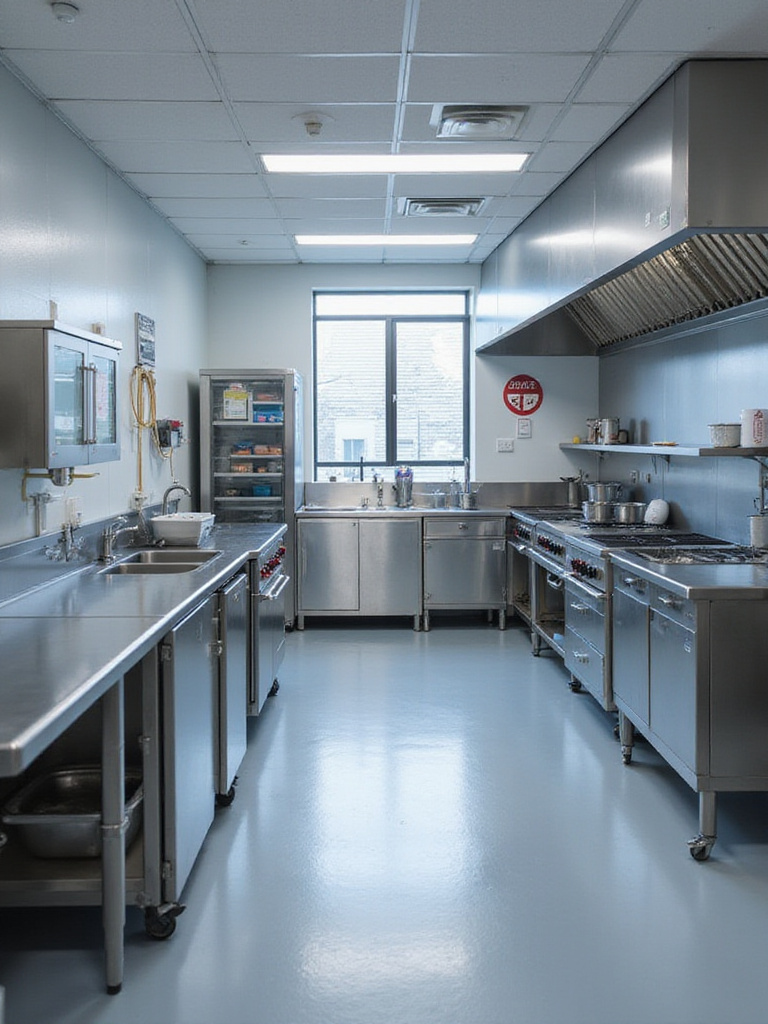
Achieving complete compliance on health inspections avoids potential fines ranging from hundreds to tens of thousands of dollars per violation, while reducing workplace accidents by up to 30% through ergonomic design and integrated safety features. This lowers insurance premiums and workers’ compensation claims while preventing operational disruptions or closures that can devastate businesses.
Compliance shouldn’t be an afterthought but must serve as a core principle guiding the entire design process. Retrofitting for compliance after construction costs exponentially more and creates significant disruption compared to integrating requirements upfront. According to OSHA data, the hospitality sector experienced 3.3 injury and illness cases per 100 full-time workers in 2022, highlighting persistent need for robust safety measures.
- Code Identification: Research all applicable federal, state, and local regulations including FDA Food Code, building codes, NFPA fire codes, and OSHA standards
- Expert Integration: Work with compliance specialists to incorporate requirements for ventilation, flooring, lighting, plumbing, and equipment spacing
- Early Consultation: Submit preliminary plans to authorities for review to identify potential issues before construction
- Documentation Development: Create comprehensive SOPs for cleaning, maintenance, and emergency procedures
A large catering facility consulted with local fire departments during design regarding exhaust hood systems, identifying potential code conflicts before construction and saving an estimated $50,000 in rework while avoiding delays.
A key aspect of maintaining hygiene and compliance involves preventing unwanted pest infiltration.
18. Design Out Pest Entry Points for Sanitation
Designing out pest entry points involves incorporating physical barriers and structural elements into industrial kitchen design to prevent rodents, insects, and birds from entering facilities. This proactive approach proves crucial for maintaining sanitation standards, preventing food contamination, and ensuring regulatory compliance in commercial food environments.
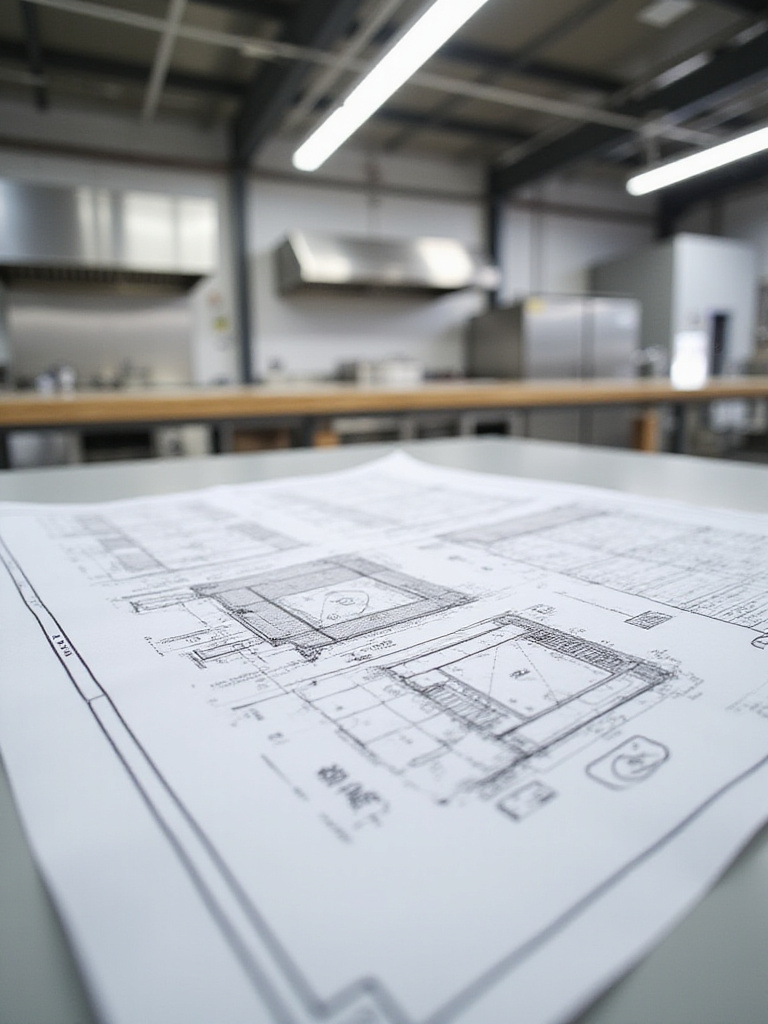
Pest exclusion design significantly reduces foodborne illness outbreak risks and associated costs including recalls and legal fees, while decreasing reliance on costly chemical pest control treatments that can disrupt operations. Integrated Pest Management (IPM) in food facilities starts with exclusion – if pests can’t be kept out, facilities face constant battles with chemicals and traps that never fully resolve the underlying problem.
This strategy also improves regulatory compliance scores during inspections, minimizing citation risks and license revocation while protecting brand reputation from pest-related incidents. Pests cause billions of dollars in damage annually to food businesses globally, making prevention far more cost-effective than remediation efforts.
Implementation requires thorough site assessment during design to identify potential vulnerabilities, then sealing all gaps and cracks using durable, non-porous materials like silicone sealant, concrete, or metal flashing. Install self-closing doors with air curtains or strip doors for frequent entry points, ensuring tight-fitting frames with sweeps and seals. Specify screens for all windows and vents with mesh size small enough to block common insects.
A large-scale bakery incorporated high-speed roll-up doors with integrated brush seals at loading docks and air curtains above frequently used entries, reporting 60% decrease in flying insect and rodent activity compared to their previous facility design.
While preventing pest entry proves vital, planning for fire emergencies requires equally serious attention.
19. Implement a Comprehensive Fire Suppression System
A comprehensive fire suppression system represents non-negotiable safety infrastructure in industrial kitchen design, automatically detecting and extinguishing fires before they spread. Given inherent risks of cooking with high heat and flammable oils, implementing robust systems protects staff, minimizes property damage, ensures business continuity, and satisfies mandatory safety regulations.
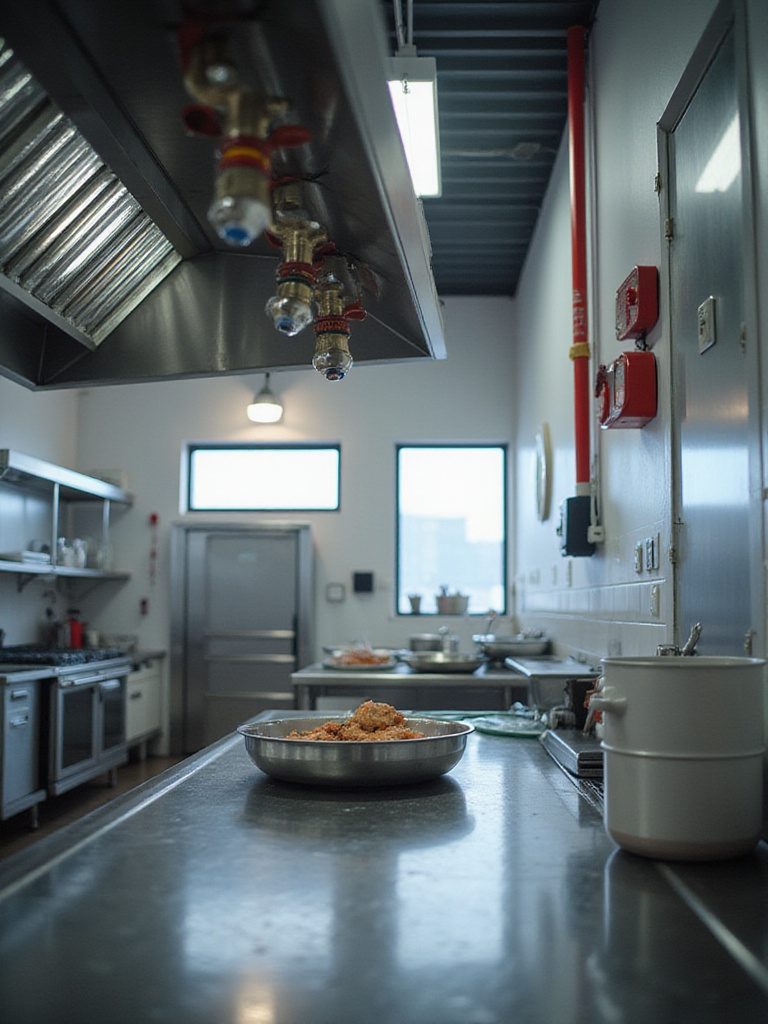
Fire suppression systems reduce potential damage costs by an estimated 96% compared to kitchens without suppression, according to NFPA data, while decreasing average business interruption time from weeks to hours or days. They may also reduce commercial property insurance premiums by 10-20% through demonstrated risk mitigation efforts.
Kitchen fire suppression systems don’t just extinguish flames – they mitigate risk at its source through proper design ensuring suppression agents reach critical areas like ductwork where fires often spread rapidly. Most importantly, these systems ensure compliance with NFPA 96 and local building regulations, avoiding fines and operational shutdowns. U.S. fire departments responded to an average of 7,610 structure fires annually in eating establishments between 2015-2019, with cooking equipment causing 61% of incidents.
- Hazard Analysis: Identify specific risks from deep fryers, charbroilers, and other high-heat equipment
- System Selection: Choose appropriate suppression type (typically wet chemical for commercial kitchens)
- Professional Design: Engage certified fire protection engineers for NFPA 96 compliant installations
- Integration Requirements: Connect with exhaust hoods, fuel shut-offs, and building fire alarm systems
A kitchen fire started in a deep fryer during peak hours but the integrated wet chemical system detected heat, automatically activated, shut off fuel sources, and suppressed the fire within seconds, limiting damage and allowing reopening the next day.
Beyond fire safety, managing waste byproducts proves essential for maintaining hygiene and operational efficiency.
20. Integrate Waste & Recycling Stations for Cleanliness
Strategically designed waste and recycling stations prove fundamental to maintaining hygiene, efficiency, and regulatory compliance in industrial kitchen design. These integrated systems minimize bacterial spread, reduce clutter, and streamline disposal processes for various waste streams from food scraps to packaging materials.
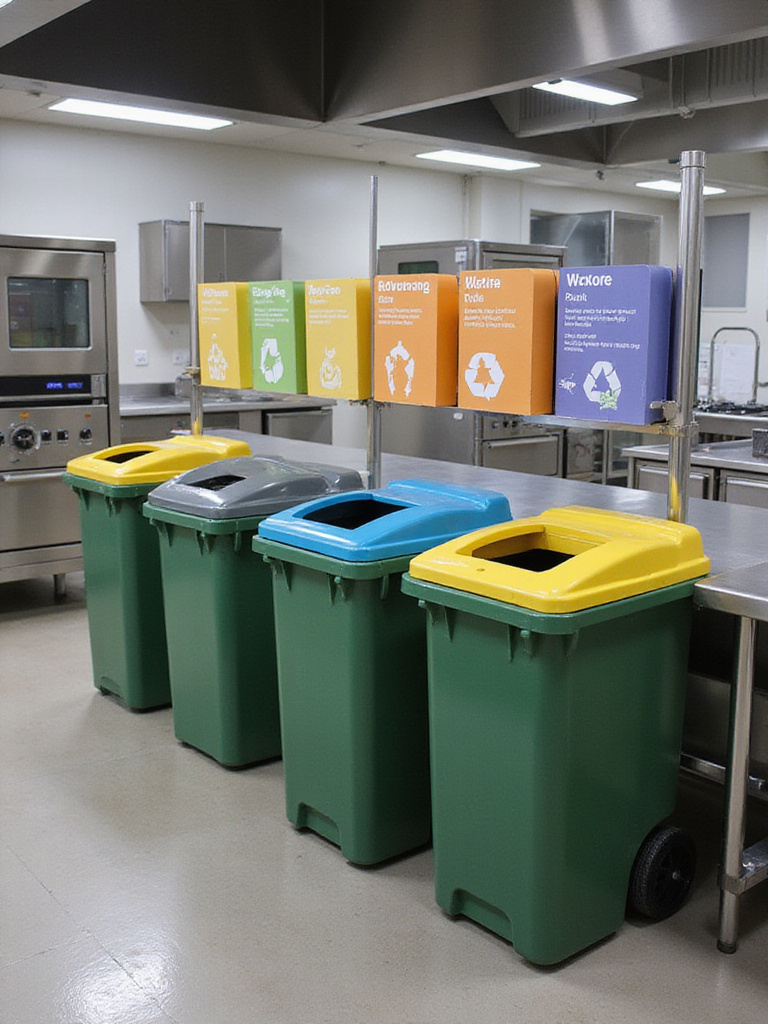
Well-integrated waste stations reduce pest infestation risks by minimizing exposed waste accumulation while improving workflow efficiency through strategic placement near prep and dishwashing areas. This decreases staff travel time and increases recycling rates, potentially lowering overall disposal costs while supporting sustainability goals. Proper waste segregation at the source proves critical – without clear bins and instructions where waste generates, everything ends up in general trash, negating recycling efforts and increasing costs.
These systems also enhance health and safety compliance by keeping waste contained and separate from food handling areas. Food service businesses generate an estimated 22-33 pounds of waste per employee daily, with food waste often representing the largest component, indicating significant volumes requiring systematic management.
Implementation requires conducting waste audits to understand types, volumes, and sources of generated waste, then designating accessible locations based on workflow and proximity to generation points. Select appropriate containers for each waste stream with adequate capacity, implementing clear, multilingual signage and color-coding systems. Establish strict removal schedules and container cleaning procedures while considering equipment like food pulpers or compactors to reduce volume.
A large university dining hall installed multiple, clearly labeled recycling and composting stations, increasing waste diversion rates by 40% within the first year while reducing landfill disposal costs.
Considering the staff who work in these environments daily proves crucial for both well-being and operational productivity.
21. Incorporate Ergonomic Design to Boost Staff Comfort
Ergonomic design in industrial kitchen design focuses on creating workspaces that minimize physical strain, fatigue, and discomfort for staff during demanding tasks. By fitting jobs to workers rather than forcing adaptation to poorly designed spaces, it significantly improves daily experiences, health outcomes, and safety for kitchen teams.
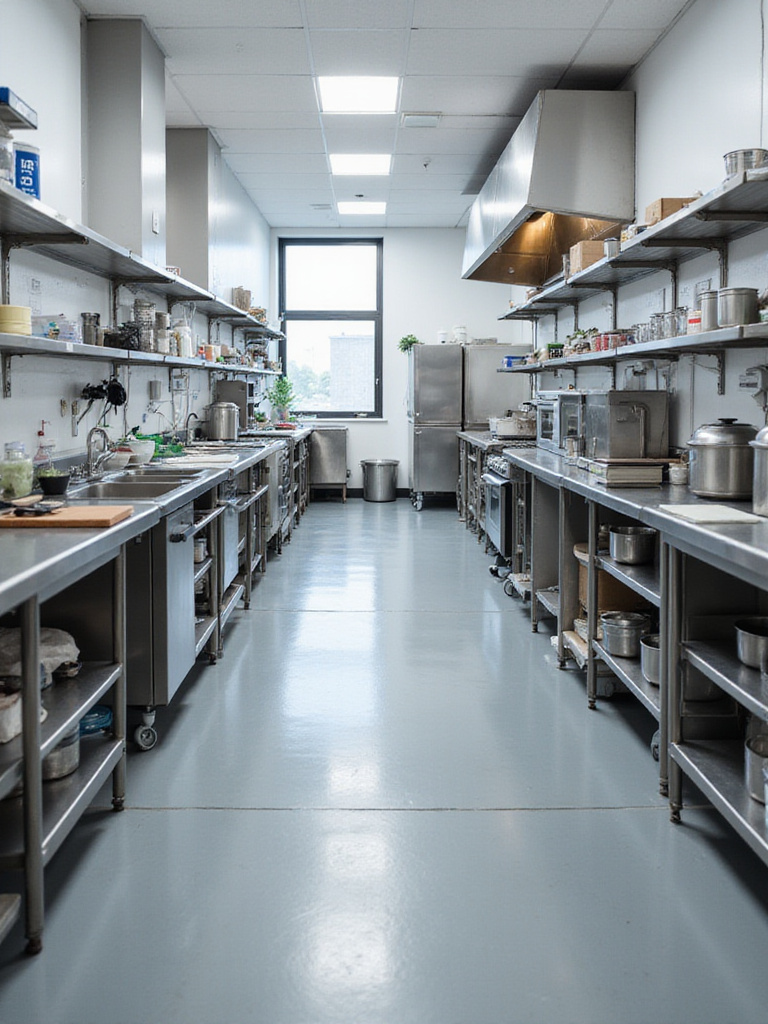
Incorporating ergonomic principles reduces musculoskeletal disorder incidence like back pain and carpal tunnel syndrome by up to 50% through minimized awkward postures and repetitive motions. It increases staff productivity and efficiency by reducing fatigue and optimizing workflow, potentially boosting output per shift by 10-15% while lowering turnover and absenteeism rates through improved working conditions.
Investing in ergonomics represents strategic workforce investment beyond just compliance requirements. Comfortable employees demonstrate greater focus, productivity, and safety consciousness in their daily tasks. Work-related musculoskeletal disorders account for 30% of all worker’s compensation costs in the U.S., with service industries being particularly affected by these preventable injuries.
- Task Analysis: Observe staff performing key kitchen tasks to identify awkward postures and repetitive motions
- Workstation Optimization: Implement adjustable-height tables, appropriate counter heights, and anti-fatigue matting
- Equipment Selection: Choose tools with ergonomic handles, reduced vibration, and minimal manual lifting requirements
- Regular Assessment: Conduct annual ergonomic evaluations involving staff feedback to identify persistent issues
A large catering kitchen implemented adjustable-height prep tables and anti-fatigue matting, reporting 40% reduction in lower back pain complaints and noticeable decrease in sick days related to physical strain within the first year.
With food prepared and cooked efficiently, the next critical point involves getting finished products to customers quickly.
22. Create a Seamless Pass-Through for Service Speed
A seamless pass-through facilitates smooth, rapid transfer of finished dishes from kitchen production lines to service staff for customer delivery. This critical component in industrial kitchen design acts as a bottleneck management point, ensuring minimal delay between food completion and service while maintaining quality and maximizing table turnover in busy operations.
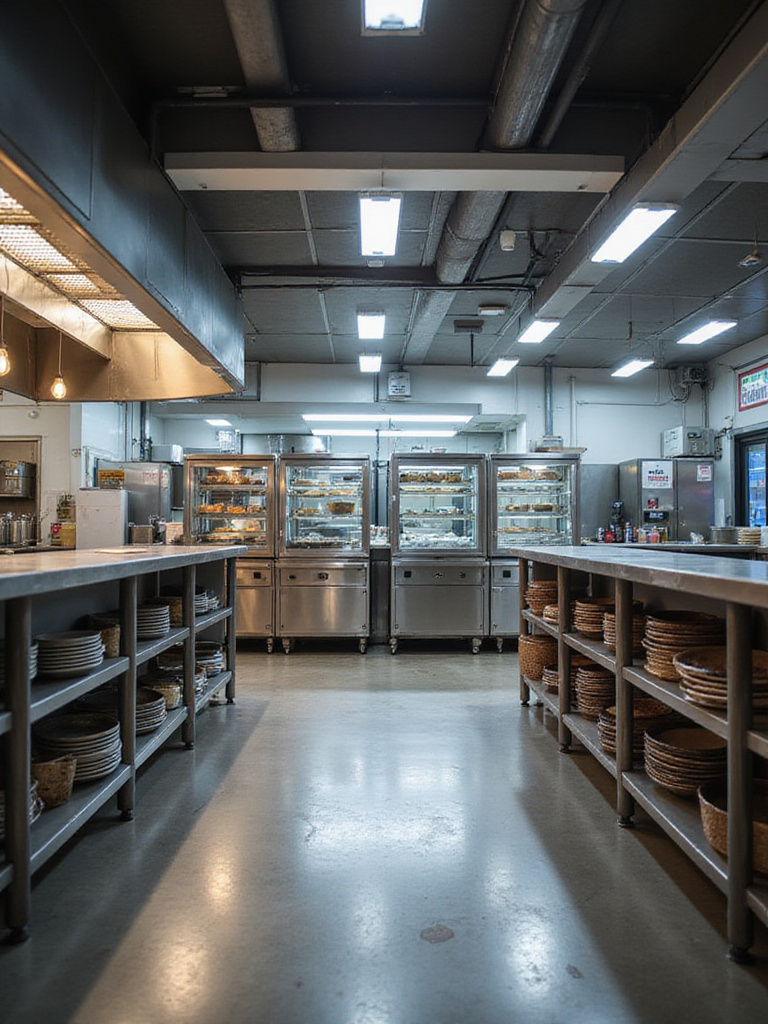
Well-designed pass-throughs reduce average ticket time by 15-20% through eliminated pickup delays and expedited communication between kitchen and service staff. They increase food temperature retention upon delivery by minimizing holding times while boosting staff efficiency through clear separation of production and service roles, reducing collisions and confusion in high-traffic areas.
The pass-through represents the heart of kitchen-to-front-of-house communication and flow. Chaotic pass-through areas slow entire operations regardless of cooking speed, making this transition point critical for overall service efficiency. Studies on kitchen workflow show that pass-through bottlenecks can increase average table turn times by 10-15 minutes during peak hours.
Implementation requires strategic location between final plating stations and service area entrances, ensuring direct, unimpeded access. Design pass-through counters at ergonomic heights for easy plate handling, incorporating heat lamps or warming shelves to maintain food temperature. Implement clear communication systems through KDS integration or structured call-out protocols to signal order completion and manage flow efficiently.
A high-volume casual dining chain redesigned their pass-through area with dedicated heated shelves and visual KDS signals, reporting 12% increase in peak hour covers and reduced customer complaints about cold food.
Looking beyond immediate operational needs, truly efficient designs must consider future requirements and adaptability.
23. Plan for Future Equipment Upgrades and Expansion
Designing industrial kitchens with future needs in mind involves anticipating potential volume increases, menu changes, and technological equipment advancements. This foresight allows incorporation of necessary infrastructure and flexible layouts during initial construction, significantly reducing costs and disruption of future upgrades or expansions.
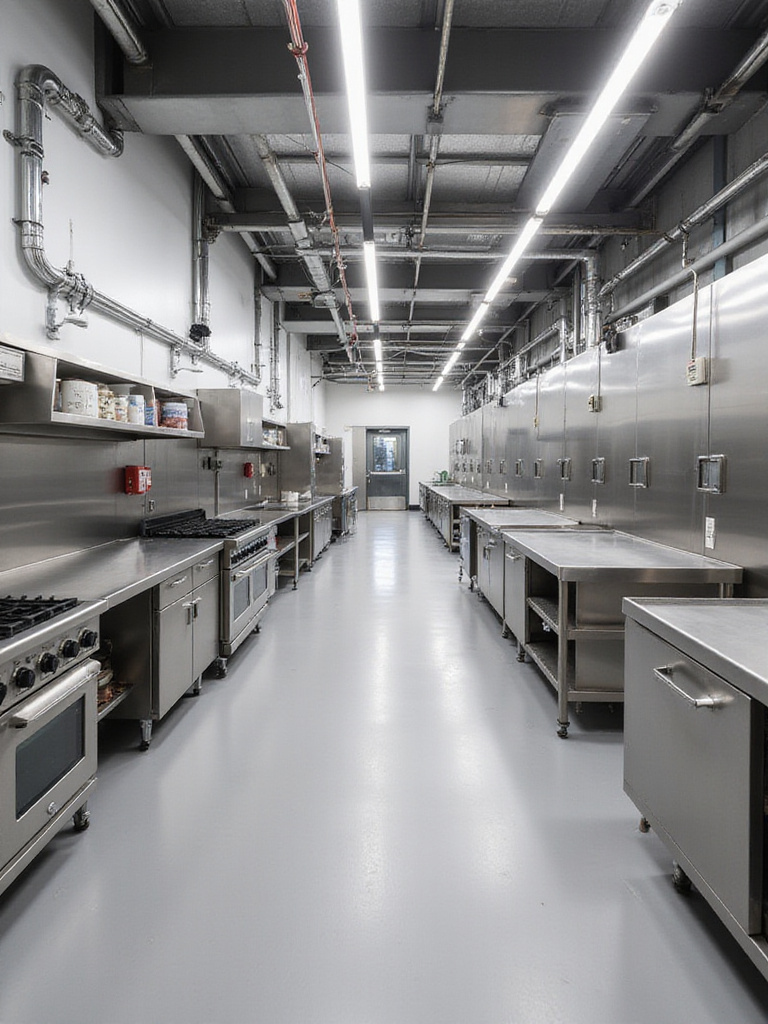
Planning for future needs reduces renovation costs by 20-40% compared to unplanned retrofitting through pre-installed utility connections and structural allowances. It minimizes operational downtime during equipment upgrades from weeks to potentially days, ensuring business continuity while increasing kitchen adaptability for quicker response to market trends or menu evolution.
Ignoring future needs during initial design drives costly kitchen renovations later. Running extra conduits or pipes during construction costs far less than breaking through walls or floors for retrofitting. Unexpected renovations due to inadequate planning can cost 1.5-2 times more per square foot than incorporating future capacity during initial builds.
- Business Projections: Conduct detailed 5-10 year growth analysis anticipating volume, staffing, and menu complexity changes
- Utility Oversizing: Install electrical panels, gas lines, water systems, and ventilation capacity beyond immediate needs
- Layout Flexibility: Design modular components with open floor space for future equipment placement
- MEP Engineering: Engage mechanical, electrical, and plumbing engineers early to calculate future load requirements
A growing fast-casual chain designed their commissary kitchen with 50% oversized electrical panels and capped utility lines in strategic locations. When doubling production capacity two years later, connections were readily available, reducing expansion timeline by 6 weeks and saving an estimated $75,000 in utility work.
Finally, ensuring ongoing kitchen functionality requires designing for maintenance accessibility from the outset.
24. Design for Easy Equipment Maintenance Access
Designing industrial kitchens with maintenance accessibility facilitates routine checks, cleaning, and repairs without significant disruption or disassembly. Strategic planning of layout, utility connections, and equipment placement ensures operational efficiency and equipment longevity while minimizing costly downtime during service periods.
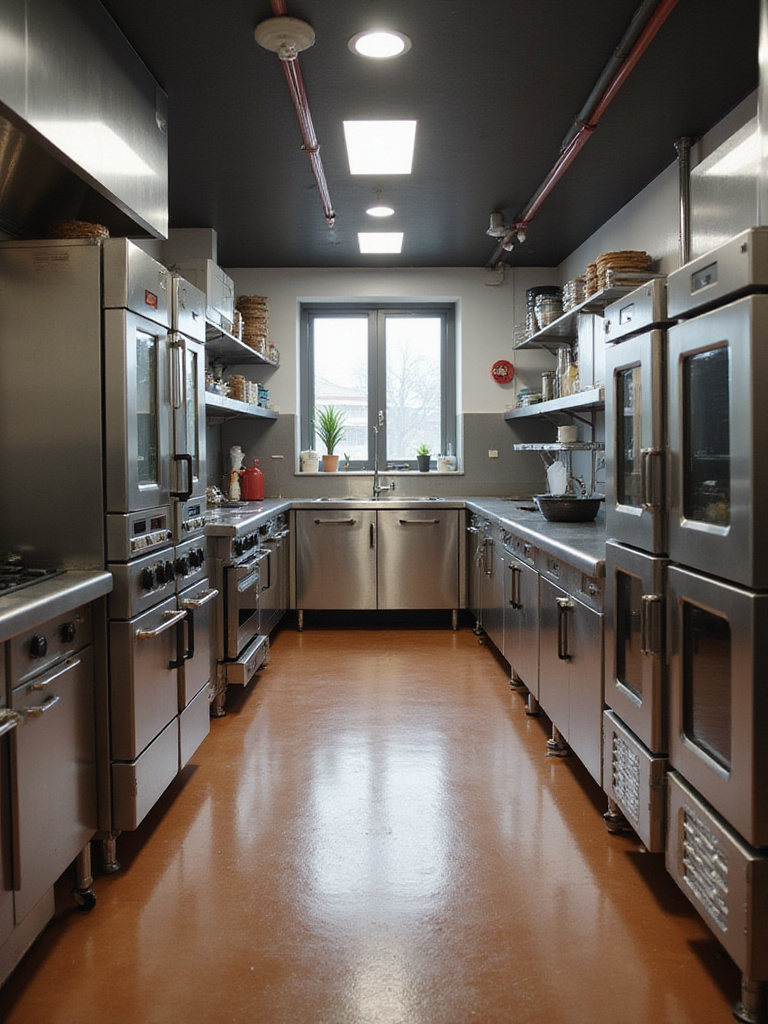
Designing for maintenance access reduces equipment downtime by 15-25% through quicker diagnostics and repairs, while lowering maintenance labor costs by minimizing time required to access components and connections. It improves food safety compliance by enabling thorough cleaning and inspection behind and under equipment – areas often neglected when access proves difficult.
Thinking about maintenance access during initial design phases costs far less than modifying finished kitchens later. This approach enables routine cleaning and inspection that prevents breakdowns rather than just facilitating repairs after problems develop. Poor equipment accessibility contributes to approximately 30% of delayed repair times in commercial kitchens, directly impacting operational flow and revenue generation.
Implementation requires specifying minimum clearance zones around major equipment for utility access and service panels, utilizing quick-disconnect fittings for easy equipment relocation, and incorporating access panels and removable components into custom fabrication. Heavy-duty lockable casters on large equipment allow easy pulling for access while maintaining stability during operation.
A large catering kitchen incorporated a 3-foot service corridor behind oven and fryer banks, enabling on-site diagnostics and repairs without moving heavy equipment, reducing average service time by 40% and eliminating off-site service costs.
The artisan collective behind these design principles understands that every detail matters in creating spaces where culinary teams can perform at their peak potential.
Conclusion
Creating an efficient industrial kitchen design represents far more than arranging equipment and meeting code requirements – it’s about engineering a high-performance environment where safety, productivity, and profitability converge seamlessly. These 24 essential strategies provide the roadmap for transforming challenging operational demands into streamlined success stories that serve your team, your customers, and your bottom line.
The journey from concept to completion requires meticulous attention to every detail, from understanding your specific menu requirements and establishing realistic budgets to selecting durable equipment and planning for future growth. Each decision builds upon the previous one, creating a comprehensive system where workflow optimization, safety compliance, and operational efficiency work together harmoniously. Remember that the most successful industrial kitchen design projects begin with clear vision and expert guidance, ensuring every square foot serves a purpose while every investment delivers measurable returns.
Your commitment to implementing these strategies will create more than just a functional workspace – you’ll build the foundation for consistent quality, operational excellence, and sustainable growth. The kitchen you design today becomes the engine that powers your culinary business forward, supporting your team’s success while delivering the exceptional experiences your customers expect and deserve.
